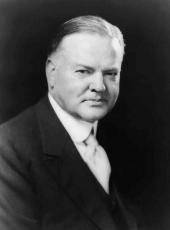THE PRESIDENT said:
"I have today signed the home loan bank bill. This institution has been created on the general lines advocated by me in a statement to the press on November 13th last. It is the outcome of the national conference on homeownership 1 which represented every part of the country. Its purpose is to establish a series of discount banks for home mortgages, performing a function for homeowners somewhat similar to that performed in the commercial field by the Federal Reserve banks through their discount facilities.
1 White House Conference on Home Building and Home Ownership.
"There are to be 8 to 12 such banks established in different parts of the country with a total capital of $125 million to be initially subscribed by the Reconstruction Finance Corporation. Building and loan associations, savings banks, insurance companies, etc. are to be eligible for membership in the system. Member institutions are required to subscribe for stock of the home loan banks and to absorb gradually the capital, and they may borrow from the banks upon their notes to be secured by the collateral of sound home mortgages.
"The home loan banks are in turn to obtain the resources required by them through the issue of debentures and notes. These notes have back of them the obligation of the members, the mortgages pledged as securities of such obligations and the capital of the home loan banks themselves. The debentures and notes thus have a triple security.
"The creation of these institutions does not involve the Government in business except in the initial work of the Reconstruction Corporation, and the setting up of the board in Washington to determine standards of practice. The cost of this board in Washington is to be paid by the home loan banks and the banks are to be owned and run by their members. In effect it is using the good offices of the Government and the Reconstruction Finance Corporation to set up cooperative action amongst these member institutions to mobilize their credit and resources. There are several thousand institutions eligible for membership.
"The purpose of the system is both to meet the present emergency and to build up homeownership on more favorable terms than exist today. The immediate credit situation has for the time being in many parts of the country restricted the activities of building and loan associations, savings banks, and other institutions making loans for home purposes, in such fashion that they are not only unable to extend credit for the acquirement of new homes, but in thousands of instances they have been unable to renew existing mortgages with resultant foreclosures and great hardships.
"A considerable part of our unemployment is due to stagnation in residential construction. There has been overbuilding in certain localities in boom years, but there has been far less than normal construction of new homes for 3 years in pace with the increase of population, and there is thus a shortage which, while now obscured by present huddling, will become evident with the first stage of recovery. Nearly 200,000 new homes are erected annually in normal times which with initial furnishing contribute $2 billion to construction and other industries. A survey by the Department of Commerce shows that there are localities in which there is today an immediate demand for homes amounting from $300 million to $500 million which could be undertaken at once if financing were available. Thus the institution should serve to immediately increase employment.
"In the long view we need at all times to encourage homeownership and for such encouragement it must be possible for homeowners to obtain long-term loans payable in installments. These institutions should provide the method for bringing into continuous and steady action the great home loaning associations which is so greatly restricted due to present pressures.
"There was attached to the bill by the Congress a rider for the limited extension of the old national bank currency. I am advised by the Treasury that in the practical working of this provision it will not result in inflation.
"The Comptroller of the Currency informs me that:
"'This section of the bill runs counter to the general plan established through the Federal Reserve Act intended gradually to do away with an inflexible bond secured currency and represents a backward step in currency and banking legislation, but in view of the fact that the provisions are limited to a 3-year period I do not feel justified in recommending that the bill be vetoed, more especially as it is a rider to an important and constructive piece of legislation to which it bears no relation.'
"I do not, therefore, feel that the amendment is such as would warrant refusal to approve the measure which means so much to hundreds of thousands of homeowners, is such a contribution to their relief; such a contribution to establishment of homeownership; and such an aid to immediate increase of employment."
Note: As enacted, the bill (H.R. 12280), approved July 22, 1932, is Public, No. 304 (47 Stat. 725).
The President referred to a rider which had been introduced by Senator Carter Glass. The amendment authorized U.S. bonds bearing up to 3 3/8 percent interest to be used as backing for national bank notes. Previous law allowed only 2 percent interest on bonds to be used as backing for national bank notes.
Herbert Hoover, Statement About Signing the Federal Home Loan Bank Act. Online by Gerhard Peters and John T. Woolley, The American Presidency Project https://www.presidency.ucsb.edu/node/207247

